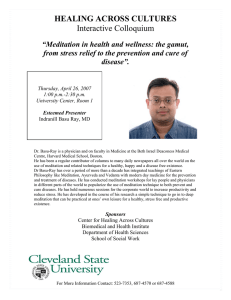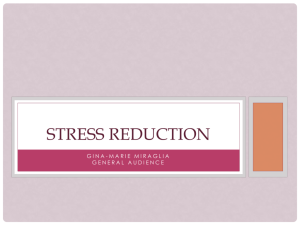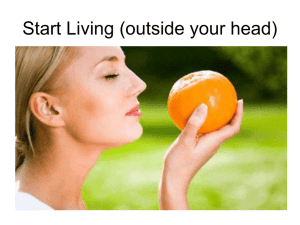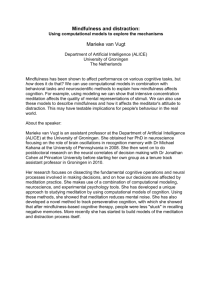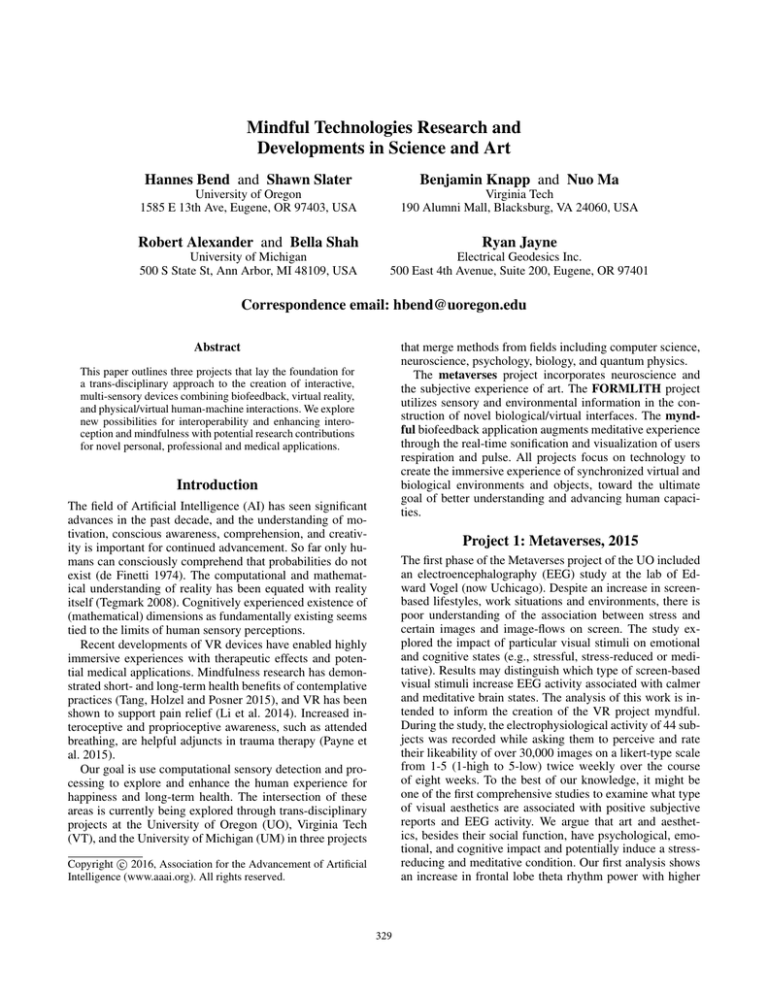
Mindful Technologies Research and
Developments in Science and Art
Hannes Bend and Shawn Slater
Benjamin Knapp and Nuo Ma
University of Oregon
1585 E 13th Ave, Eugene, OR 97403, USA
Virginia Tech
190 Alumni Mall, Blacksburg, VA 24060, USA
Robert Alexander and Bella Shah
Ryan Jayne
University of Michigan
500 S State St, Ann Arbor, MI 48109, USA
Electrical Geodesics Inc.
500 East 4th Avenue, Suite 200, Eugene, OR 97401
Correspondence email: hbend@uoregon.edu
that merge methods from fields including computer science,
neuroscience, psychology, biology, and quantum physics.
The metaverses project incorporates neuroscience and
the subjective experience of art. The FORMLITH project
utilizes sensory and environmental information in the construction of novel biological/virtual interfaces. The myndful biofeedback application augments meditative experience
through the real-time sonification and visualization of users
respiration and pulse. All projects focus on technology to
create the immersive experience of synchronized virtual and
biological environments and objects, toward the ultimate
goal of better understanding and advancing human capacities.
Abstract
This paper outlines three projects that lay the foundation for
a trans-disciplinary approach to the creation of interactive,
multi-sensory devices combining biofeedback, virtual reality,
and physical/virtual human-machine interactions. We explore
new possibilities for interoperability and enhancing interoception and mindfulness with potential research contributions
for novel personal, professional and medical applications.
Introduction
The field of Artificial Intelligence (AI) has seen significant
advances in the past decade, and the understanding of motivation, conscious awareness, comprehension, and creativity is important for continued advancement. So far only humans can consciously comprehend that probabilities do not
exist (de Finetti 1974). The computational and mathematical understanding of reality has been equated with reality
itself (Tegmark 2008). Cognitively experienced existence of
(mathematical) dimensions as fundamentally existing seems
tied to the limits of human sensory perceptions.
Recent developments of VR devices have enabled highly
immersive experiences with therapeutic effects and potential medical applications. Mindfulness research has demonstrated short- and long-term health benefits of contemplative
practices (Tang, Holzel and Posner 2015), and VR has been
shown to support pain relief (Li et al. 2014). Increased interoceptive and proprioceptive awareness, such as attended
breathing, are helpful adjuncts in trauma therapy (Payne et
al. 2015).
Our goal is use computational sensory detection and processing to explore and enhance the human experience for
happiness and long-term health. The intersection of these
areas is currently being explored through trans-disciplinary
projects at the University of Oregon (UO), Virginia Tech
(VT), and the University of Michigan (UM) in three projects
Project 1: Metaverses, 2015
The first phase of the Metaverses project of the UO included
an electroencephalography (EEG) study at the lab of Edward Vogel (now Uchicago). Despite an increase in screenbased lifestyles, work situations and environments, there is
poor understanding of the association between stress and
certain images and image-flows on screen. The study explored the impact of particular visual stimuli on emotional
and cognitive states (e.g., stressful, stress-reduced or meditative). Results may distinguish which type of screen-based
visual stimuli increase EEG activity associated with calmer
and meditative brain states. The analysis of this work is intended to inform the creation of the VR project myndful.
During the study, the electrophysiological activity of 44 subjects was recorded while asking them to perceive and rate
their likeability of over 30,000 images on a likert-type scale
from 1-5 (1-high to 5-low) twice weekly over the course
of eight weeks. To the best of our knowledge, it might be
one of the first comprehensive studies to examine what type
of visual aesthetics are associated with positive subjective
reports and EEG activity. We argue that art and aesthetics, besides their social function, have psychological, emotional, and cognitive impact and potentially induce a stressreducing and meditative condition. Our first analysis shows
an increase in frontal lobe theta rhythm power with higher
c 2016, Association for the Advancement of Artificial
Copyright Intelligence (www.aaai.org). All rights reserved.
329
liked images averaged over all participants.
The second phase of this project involved collecting fMRI
and EEG data to explore neural activation during meditation.
There is no clear consensus currently about what constitutes
a meditative brain state; however, research suggests that the
presence of increased theta waves is associated with meditative states (Dahl, Davidson and Lutz 2015). Succeeding
studies on mindfulness meditation, UO scientist and Professor Michael Posner hypothesized that frontal theta induced
by meditation produces a molecular cascade that increases
white matter growth and improves neural network connectivity (Posner, Tang and Lynch 2014).
Based on current research, we recorded experienced meditation practitioners with EEG and also observed a higher
frontal theta power during EEG recordings specifically with
open awareness and body-scan meditation techniques. Subsequently, in collaboration with Michael Posner, we conducted an fMRI- based study to compare meditation techniques within subjects. First results show a high activation of
multiple neural networks during the body-scan meditation.
Bringing the body or specific body regions into mental focus may be linked to a recent rediscovery of a human ability
to the voluntary activate the autonomic nervous system (Kox
et al. 2014). Attended breathing and meditation tasks are integral parts of the Wim Hof training program to voluntarily
activate the autonomic nervous system and consciously suppress inflammatory responses of the immune system. The research and studied techniques inspired the myndful project.
provide potentially new emerging perspectives about reality through the virtual and digital sensory processing of exogenous signals for enhanced comprehension with potential
machine learning applications.
Project 3: myndful
Researchers from the UO and UM are developing software
incorporating real-time biofeedback of endogenous signals
(respiration, pulse, and heart rate variability (HRV). The
sonification and visualization of the user’s physiology is realized through custom parameter-mapping algorithms. This
biofeedback is intended to enable user mindfulness, fitness
and breath control. The UM team is finalizing the sound
and visual-based application titled Breath of Life. The UO
team is creating a VR visualization program with biofeedback (HRV) and possible neurofeedback via EEG. Based on
our current program design, the user will be immersed in visualizations and audio in-sync with the heart rate with the
intention to reduce stress and anxiety.
Heart rate and HRV provide a window to the autonomic
nervous system (Lehrer and Gevirtz 2014). The alteration of
the autonomic nervous system has been linked with a correlation between theta oscillations and high-frequency HRV
in short-term meditation practices (Tang et al. 2009), and an
increase in theta with wider brain network of body-schema,
somatosensory and motor-related areas (Wang et al. 2016),
power of frontal theta with the perception of 3D VR experiences with a higher sense of presence (Slobounov et al.
2015). Conscious breathing tasks are also an integral component of many ancient meditation practices and somatic contemplative practices enabling the practitioners to raise their
core body temperature (CBT) consciously (Kozhevnikov et
al. 2013). We are currently developing a study investigating
subjective states, EEG, CBT, HRV, and oxygen consumption in an attended breathing task of virtual reality users. We
investigate how to access and enhance new neuroimmunological abilities through technology, especially in the light
of the discovery of the connection of the brain to the immune system (Louveau et al. 2015). The research insights
will influence and update the computational and creative developments of the myndful app.
Project 2: FORMLITH
The Mirror Worlds project of the Institute for Creativity,
Arts, and Technology (ICAT) at VT explores a fusion of
real and virtual realities by converging Building Information Modeling, multiple sensory information including thermal imaging and persistent, online, multi-user virtual environments. The aim is to analyze the effects of virtual environments on performance in physical environments and to
enable new possibilities for situational experience and telepresence. As an infrastructure targeting the support of diverse research based on multiple sensory information, it provides measurement of motion includes Kinects, blob tracking cameras, and localization microphones. The raw and
processed data is also exposed to 3D virtual worlds clients.
This dedicated physical sensor-drenched spaces is located in
Virginia Tech Moss Arts Center building.
Our team of VT and UO researchers started to develop a
motion and thermal wavelength detecting program and interface in this infrastructure to create a shared space with
interactions between the physical biological response and
virtual representation. Wavelengths of the electromagnetic
spectrum perceivable to the human sensory perception are
essential for human cognition and interpretation of reality,
and the focus is to access, sonify and visualize wavelengths
and realms of reality only accessible through technology.
The findings of the neuroaesthetics studies at the UO about
which type of images (fractals, CGI etc.) are perceived as
calming will be combined with the methods employed at
VT. The interactive human/machine hybrid interface will
Conclusions
The metaverses, FORMLITH and myndful projects offer new insights into the reality of nature through human/machine interaction, and the possibility to selfmodulate ones autonomic nervous system. The project myndful could have positive implications with improved cognitive activity, immune system responses, adaptation to cold
environments and differing circadian cycles, stress- and
anxiety-reduction, heightened sense of presence, integration
and degree of happiness. This work could provide short-term
and long-term health benefits and be used in private and professional environments, clinical research and for educational
purposes. The new immersive mindful technology interfaces
offer access to untapped potential and benefits of ancient and
contemporary mindfulness practices to rediscover and/or enhance human capacities.
330
Reconstructing and deconstructing the self: cognitive mechanisms in meditation practice. Dahl, C. J., Davidson,
R. J., Lutz, A. 2015. Trends Cogn. Sci. 19 515523.
10.1016/j.tics.2015.07.001
Theory of Probability, Vol. 1. New York: John Wiley and
Sons. de Finetti, B. (1974)
Voluntary activation of the sympathetic nervous system and
attenuation of the innate immune response in humans. Kox,
M., van Eijk, LT., Zwaag, J., van den Wildenberg, J., Sweep,
FC., van der Hoeven, JG., Pickkers, P. 2014. Proc. Natl
Acad. Sci. USA. 111: 73797384.
Neurocognitive and Somatic Components of Temperature
Increases during g-Tummo Meditation: Legend and Reality. Kozhevnikov, M., Elliott, J., Shephard, J., Gramann, K.
2013. PLOS One. 2013;8(3):e58244.
Heart rate variability biofeedback: how and why does it
work? Lehrer, P. & Gevirtz, R. 2014. Frontiers in Psychology, 5, 756.
Virtual reality and pain management: current trends and future directions. Li, A., Montano, Z., Chen, VJ., Gold, JI.
2011. Pain Manag 1[2]:147-57.
Structural and functional features of central nervous system
lymphatic vessels. Louveau, A., Smirnov, I., Keyes, T.J., Eccles, J.D., Rouhani, S.J., Peske, J.D., Derecki, N.C., Castle, D., Mandell, J.W., Lee, K.S., Harris, T.H., Kipnis, J.,
2015.Nature. doi:10.1038/nature14432
Somatic experiencing: using interoception and proprioception as core elements of trauma therapy..Payne, P., Levine, P.
A., &. Crane-Godreau, M. A. 2015.Frontiers in Psychology,
6:93. Doi: 10.3389/fpsyg.2015.00093
Mechanisms of white matter change induced by meditation
training. Posner, MI., Tang, YY., Lynch, G. 2014. Front Psychol 5 Article 1220.
Modulation of cortical activity in 2D versus 3D virtual reality environments: An EEG study. Slobounov, S. M., Ray, W.,
Johnson, B., Slobounov, E., Newell, K. M. 2015. Int. J. Psychophysiol. 95, 254260. 10.1016/j.ijpsycho.2014.11.003
Central and autonomic nervous system interaction is altered by short-term meditation. Tang, Y. Y., Ma, Y., Fan,
Y., Feng, H., Wang, J., Feng, S., et al. 2009. Proceedings
of the National Academy of Sciences, 106(22), 88658870.
doi:10.1073/pnas.0904031106.
The neuroscience of mindfulness meditation.
Tang,
YY., Holzel, BK., Posner, MI. 2015. Nat Rev Neurosci.16(4):21325.
The Mathematical Universe. Tegmark, M. 2008. Foundations of Physics 38, 101 150.
Rhythm makes the world go round: An MEG-TMS study on
the role of right TPJ theta oscillations in embodied perspective taking. Wang et al. 2016 Cortex. 25;75:68-81. doi:
10.1016/j.cortex.2015.11.011.
331



